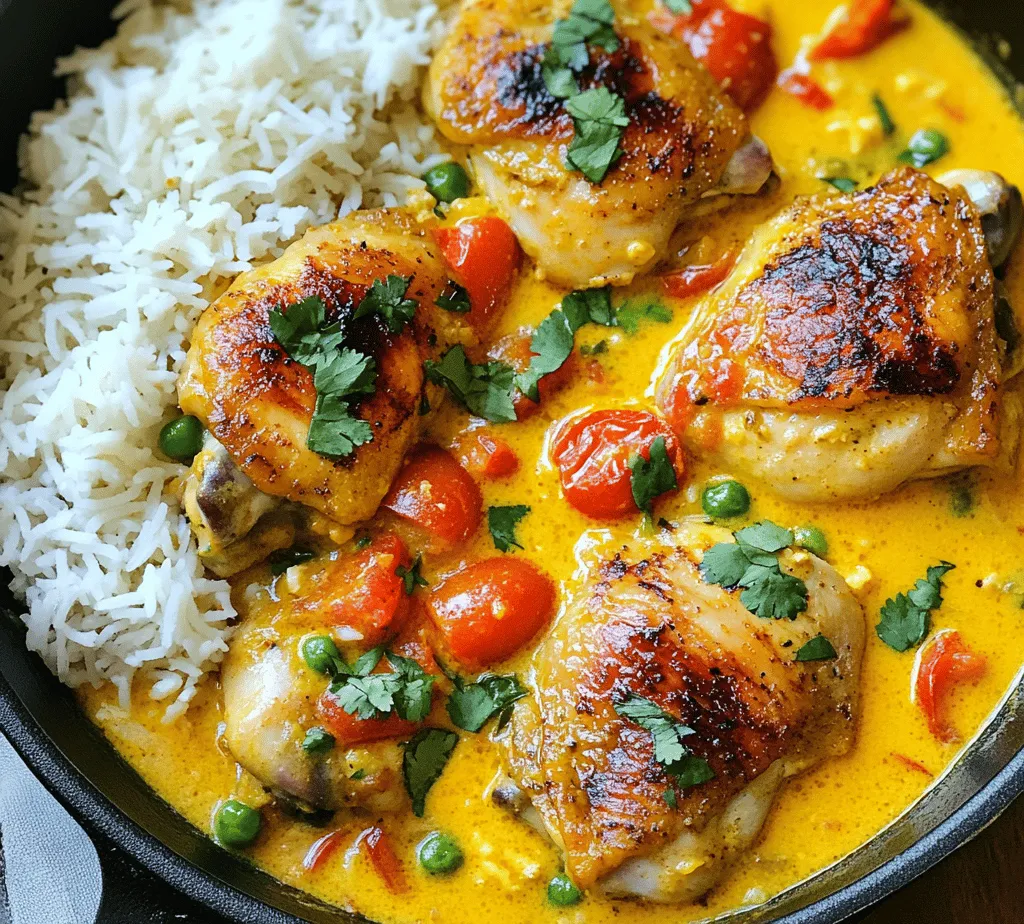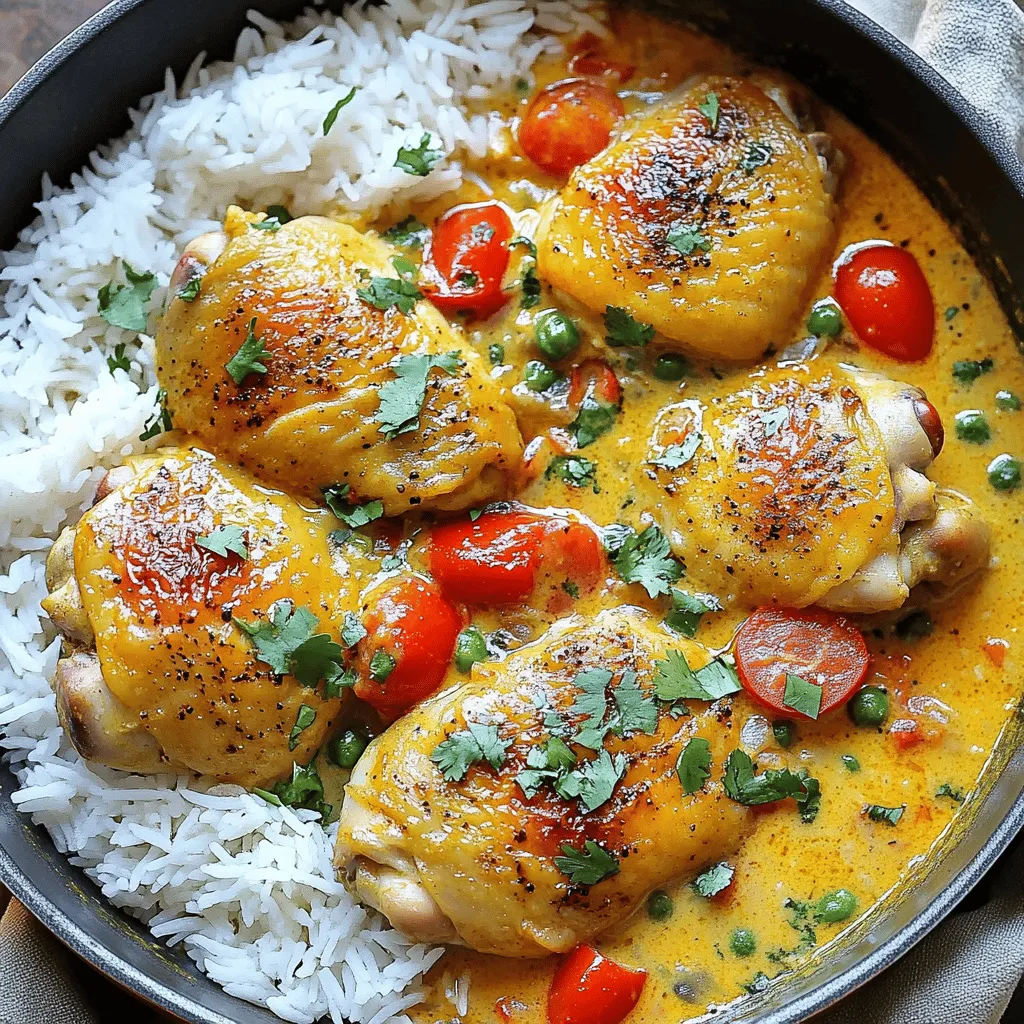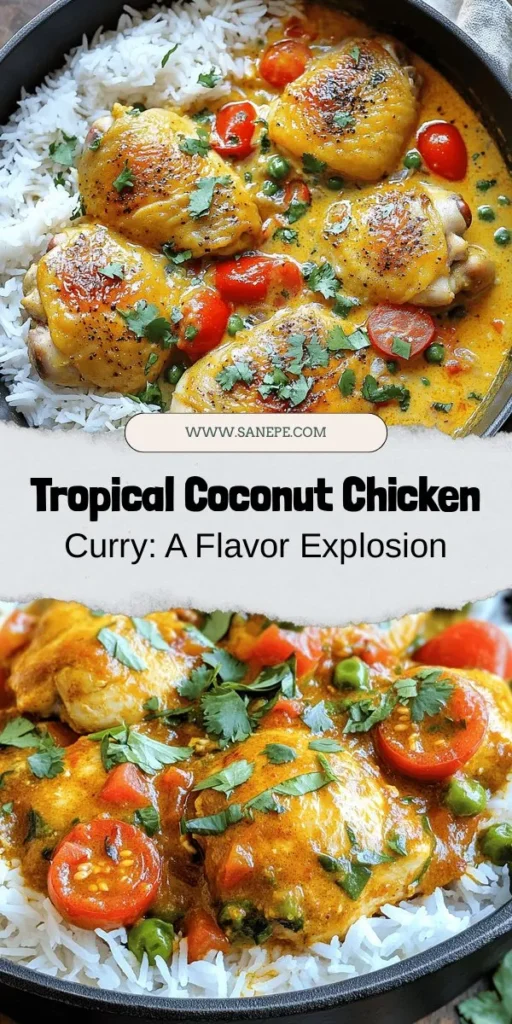Introduction
Tropical Indian Coconut Chicken Curry is a delightful dish that brings together the rich, aromatic spices of Indian cuisine with the fresh, vibrant flavors of tropical ingredients. This curry is a celebration of two culinary worlds, resulting in a dish that is not only comforting but also invigorating. Imagine tender chicken simmered in a creamy coconut sauce, enhanced with spices and a hint of tanginess. It’s the perfect meal for family dinners, special occasions, or whenever you want to treat your taste buds to something extraordinary.
What sets this curry apart is its accessibility. Despite its impressive flavors and appearance, the recipe is straightforward, making it an excellent choice for both novice cooks and seasoned chefs. With just a few key ingredients and simple preparation steps, you can create a dish that feels gourmet yet is easy enough for a weeknight meal. The comforting nature of this curry, combined with its tropical twist, makes it a favorite in many households.
Understanding the Key Ingredients
To truly appreciate and execute the Tropical Indian Coconut Chicken Curry, it’s essential to understand the key ingredients that play a vital role in its flavor profile and overall appeal.
Chicken Thighs
For this curry, boneless, skinless chicken thighs are the star of the show. Unlike chicken breasts, thighs are inherently more tender and juicy, which makes them ideal for slow cooking in sauces. This cut absorbs flavors beautifully and remains moist throughout the cooking process, ensuring that each bite is rich and satisfying. The choice of chicken thighs not only elevates the texture of the dish but also complements the creamy coconut sauce perfectly.
Coconut Oil
Coconut oil is another critical ingredient in this recipe, contributing both flavor and health benefits. Known for its distinct tropical aroma, coconut oil adds a unique richness to the curry. It has a high smoke point, making it ideal for cooking at higher temperatures without breaking down. Additionally, coconut oil is celebrated for its potential health benefits, including boosting metabolism and supporting heart health. Using coconut oil as the base for your curry not only enhances the dish’s flavor but also aligns with the tropical theme.
Aromatics
The foundation of any great curry lies in its aromatics. In this recipe, onion, garlic, ginger, and green chilies play a vital role in building the base flavor. The onions provide sweetness and depth, while garlic and ginger add a pungent kick that is essential in Indian cooking. Green chilies introduce a welcome heat, which can be adjusted according to your preference. Sautéing these aromatics properly releases their essential oils, creating a fragrant base that will elevate the entire dish.
Spices
Spices are the heart and soul of Indian cuisine, and this curry is no exception. The use of cumin seeds, mustard seeds, turmeric, coriander, and garam masala not only adds complexity but also brings numerous health benefits.
– Cumin Seeds: Known for their earthy flavor, cumin seeds aid digestion and have anti-inflammatory properties.
– Mustard Seeds: These seeds add a subtle spiciness and are rich in antioxidants.
– Turmeric: Renowned for its anti-inflammatory and antioxidant benefits, turmeric gives the curry its vibrant yellow color.
– Coriander: Both the seeds and fresh leaves (cilantro) contribute a citrusy note that brightens the dish.
– Garam Masala: A blend of spices that varies by region, garam masala adds warmth and depth, creating a harmonious balance of flavors.
Coconut Milk
Coconut milk is what transforms this curry into a creamy, luxurious experience. Its richness softens the spices and creates a smooth texture that coats the chicken beautifully. Coconut milk is naturally sweet, which helps balance the heat from the spices and the acidity from other ingredients, resulting in a well-rounded flavor profile. It’s also a great dairy-free alternative, making this dish suitable for those with lactose intolerance.
Diced Tomatoes
Diced tomatoes are crucial for adding acidity and balancing the richness of the coconut milk. They provide a fresh burst of flavor that cuts through the creaminess, ensuring the curry is not overly heavy. The tomatoes also contribute to the overall texture of the dish, creating a sauce that clings to the chicken perfectly.
Tamarind Paste (Optional)
For those looking to add an extra layer of flavor, tamarind paste can be included for its tangy profile. Tamarind adds a unique sourness that contrasts beautifully with the sweetness of the coconut milk and the spices. This optional ingredient can elevate the dish, providing complexity and enhancing the tropical vibe of the curry.
Preparation Steps Explained
Now that we have a solid understanding of the key ingredients, let’s dive into the preparation steps required to create this Tropical Indian Coconut Chicken Curry. Each step is designed to maximize flavor and ensure that the dish comes out perfect every time.
Heating the Coconut Oil
The first step in preparing your Tropical Indian Coconut Chicken Curry is to heat the coconut oil in a large pan over medium heat. Proper heating of the oil is essential, as it allows the flavors from the spices to be released effectively. Once the oil has melted and is shimmering, you’re ready to add your spices. The goal is to create a fragrant base that will infuse the entire dish with flavor.
Sautéing Aromatics
Once the coconut oil is heated, it’s time to introduce the aromatics. Start by adding finely chopped onions to the pan. Sauté them until they become golden brown, which typically takes around 5 to 7 minutes. This step is crucial, as golden brown onions develop a sweet, caramelized flavor that enhances the curry base.
Next, add minced garlic and ginger, followed by chopped green chilies. Cook these ingredients for an additional 2-3 minutes, stirring frequently to prevent burning. The aroma that fills your kitchen at this point will be enticing, signaling that you are on the right track to creating a delicious curry.
After this, the spices can be introduced. Add cumin seeds and mustard seeds to the pan, allowing them to sizzle for about 30 seconds. This process helps to release their essential oils and flavors, making your curry even more aromatic. Be careful not to let them burn, as this can lead to a bitter taste.
Following the spices, sprinkle in turmeric, coriander, and garam masala, stirring everything together to combine. The vibrant colors of the spices will create a beautiful mosaic in the pan, showcasing the dish’s exciting flavor profile.
Next, it’s time to add the chicken thighs to the pan. Cut them into bite-sized pieces for even cooking and to make servings easier later on. Sear the chicken in the spice mixture until it’s no longer pink on the outside, which should take about 5-7 minutes. This step is vital, as browning the chicken adds depth to the flavor and ensures it is well-coated in the aromatic spices.
As you move forward with the recipe, you’ll be layering flavors and building complexity, creating a dish that is sure to impress. The following steps will guide you through the addition of coconut milk, diced tomatoes, and any other remaining ingredients, ensuring that you craft the perfect Tropical Indian Coconut Chicken Curry.
Stay tuned for the next part, where we will delve into the final touches that will bring this dish to life, making it a standout on your dining table.

Toasting the Spices
Toasting spices is a fundamental technique that transforms the flavor profile of any dish, especially in Indian cuisine. When you toast spices, you release essential oils that enhance their natural flavors, making them more aromatic and robust. For this Tropical Indian Coconut Chicken Curry, begin by heating a dry skillet over medium heat. Add the whole spices—such as cumin seeds, coriander seeds, and mustard seeds—allowing them to cook for 1-2 minutes until they become fragrant. Be sure to shake the pan gently to prevent them from burning.
Once toasted, transfer the spices to a mortar and pestle or a spice grinder. Grind them into a fine powder; this step releases even more flavors and helps to incorporate the spices evenly throughout the curry. This freshly toasted spice blend will serve as the backbone of your curry, providing an aromatic foundation that pairs beautifully with the coconut milk and chicken.
Cooking the Chicken
With your spices ready, it’s time to cook the chicken. Begin by heating a tablespoon of oil in a large pot or Dutch oven over medium-high heat. It’s essential to use a high smoke-point oil like vegetable or coconut oil to ensure even cooking without burning. Season the chicken pieces with salt and pepper before adding them to the hot oil.
To achieve a perfect golden-brown crust on the chicken, avoid overcrowding the pot. If necessary, work in batches to ensure even cooking. Let the chicken sear undisturbed for a few minutes until it develops a golden-brown exterior, then flip the pieces to brown the other side. This browning process not only adds depth of flavor but also creates a beautiful color in the final dish. Once browned, remove the chicken and set it aside while you prepare the sauce.
Adding Coconut Milk and Tomatoes
Now comes the star of the dish: the combination of coconut milk and tomatoes. After removing the chicken, add chopped onions, garlic, and ginger to the pot. Sauté these aromatics until they become translucent and fragrant, about 3-4 minutes. This step is crucial as it builds the base flavor of your curry.
Next, add your toasted spice powder and cook for an additional minute, stirring constantly to prevent sticking. Once the spices are fragrant, it’s time to add diced tomatoes. Fresh or canned tomatoes work well here; they provide acidity that balances the richness of the coconut milk. Stir the mixture well, allowing the tomatoes to break down and incorporate into the sauce.
After the tomatoes, pour in the coconut milk, stirring to combine everything into a smooth, creamy mixture. The coconut milk not only adds richness but also lends a subtle sweetness that enhances the overall flavor. It’s this combination of coconut and tomatoes that creates a luscious sauce, perfect for enveloping the chicken.
Simmering the Curry
Simmering is a critical step in developing the flavors of your curry and ensuring that the chicken stays tender. Once you’ve added the coconut milk, return the browned chicken pieces to the pot. Bring the mixture to a gentle boil, then reduce the heat to low and cover the pot. Allow the curry to simmer for at least 30 minutes, stirring occasionally.
During this time, the chicken will absorb the flavors of the sauce, and the sauce itself will thicken slightly. If you prefer a thicker curry, you can simmer it longer, allowing the liquid to reduce further. Remember to taste and adjust the seasoning as needed, adding salt or a pinch of sugar to balance the flavors.
Final Seasoning and Garnishing
As your curry nears completion, it’s time for the final touches. Taste the sauce and adjust the salt according to your preference; this step is essential as it amplifies all the flavors in the dish. Just before serving, stir in a generous amount of freshly chopped cilantro. This herb not only adds a pop of color but also imparts a fresh, aromatic quality that enhances the dish’s overall appeal.
For an added kick, you can include a squeeze of fresh lime juice at this stage, which brightens the flavors and adds a zesty finish to the curry. Once everything is well combined and heated through, your Tropical Indian Coconut Chicken Curry is ready to serve!
Serving Suggestions
When it comes to serving your Tropical Indian Coconut Chicken Curry, consider pairing it with steamed basmati rice. The fluffy, aromatic grains of basmati rice complement the creamy curry perfectly, providing a wonderful texture contrast.
Warm naan is another ideal accompaniment. This traditional Indian bread is perfect for scooping up the curry and adds a delightful chewiness to the meal. You can also serve this dish with a side of cooling raita—a yogurt-based condiment—to balance the spice and richness of the curry.
For an elegant presentation, consider serving the curry in a large bowl, garnished with additional cilantro leaves and a sprinkle of chili flakes for color. A side of lime wedges can also enhance the visual appeal and provide an extra zing for those who enjoy a tart flavor.
Nutritional Information
Understanding the nutritional aspects of your Tropical Indian Coconut Chicken Curry can enhance your enjoyment of this dish. A standard serving (approximately one cup) generally contains around 400-500 calories, depending on the specific ingredients used. The breakdown typically includes:
– Protein: 25-30 grams from the chicken
– Fats: 20-25 grams, primarily from the coconut milk
– Carbohydrates: 30-35 grams, mainly from the accompanying rice or naan
This curry is rich in healthy fats from coconut milk, which provides medium-chain triglycerides (MCTs) that can be beneficial for energy and metabolism. Additionally, the spices used, such as turmeric and ginger, are known for their anti-inflammatory properties, making this not just a comforting meal but also a nutritious one.
Cultural Significance
Tropical Indian Coconut Chicken Curry is deeply rooted in the diverse culinary traditions of India. The use of coconut milk is particularly prominent in South Indian cuisine, where coconut trees flourish. This ingredient reflects the region’s agricultural practices and showcases the influence of tropical ingredients in Indian cooking.
The dish represents a fusion of cultures, where Indian spices meet the richness of coconut, often found in Southeast Asian cuisine. The blending of these elements highlights the adaptability of Indian cooking and its ability to incorporate external flavors while maintaining its authentic essence.
Coconut chicken curry is not just a meal; it embodies the shared stories and traditions of families coming together to enjoy a hearty dish that transcends borders. Each region in India may have its variation, showcasing local spices and cooking techniques that make this dish a beloved classic.
Conclusion
In summary, the Tropical Indian Coconut Chicken Curry is a delightful blend of flavors and textures that promises to transport you to a tropical paradise with every bite. The preparation process, from toasting spices to simmering the chicken in a creamy coconut sauce, is an enjoyable journey that highlights the joy of cooking.
As you embrace this culinary adventure, remember that cooking is about experimentation and sharing delicious meals with loved ones. This recipe is not just a way to nourish your body; it’s an opportunity to create lasting memories around the dinner table. So, gather your ingredients, follow the steps, and indulge in the rich flavors of this Tropical Indian Coconut Chicken Curry. It’s a dish that invites you to savor every moment, and we hope you relish the experience as much as the final dish.

